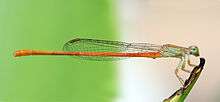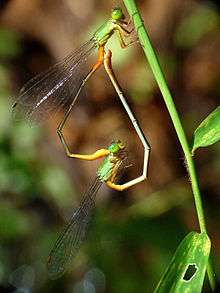Ceriagrion
Ceriagrion is a genus of damselfly in the family Coenagrionidae.[2] Species of Ceriagrion are small to medium size, generally brightly coloured damselflies. They are found across the Old World, Africa, Asia and Australia.[3]
| Ceriagrion | |
|---|---|
 | |
| Male Ceriagrion glabrum | |
 | |
| Female Ceriagrion glabrum | |
| Scientific classification | |
| Kingdom: | Animalia |
| Phylum: | Arthropoda |
| Class: | Insecta |
| Order: | Odonata |
| Suborder: | Zygoptera |
| Family: | Coenagrionidae |
| Genus: | Ceriagrion Selys, 1876[1] |

Ceriagrion cerinorubellum mating
Species
The genus Ceriagrion includes the following species:[4]
- Ceriagrion aeruginosum (Brauer, 1869) – Redtail[3]
- Ceriagrion annulatum Fraser, 1955
- Ceriagrion annulosum Lieftinck, 1934
- Ceriagrion auranticum Fraser, 1922
- Ceriagrion auritum Fraser, 1951
- Ceriagrion azureum (Selys, 1891)
- Ceriagrion bakeri Fraser, 1941
- Ceriagrion batjanum Asahina, 1967
- Ceriagrion bellona Laidlaw, 1915
- Ceriagrion calamineum Lieftinck, 1951
- Ceriagrion cerinorubellum (Brauer, 1865)
- Ceriagrion chaoi Schmidt, 1964
- Ceriagrion citrinum Campion, 1914
- Ceriagrion coeruleum Laidlaw, 1919
- Ceriagrion corallinum Campion, 1914
- Ceriagrion coromandelianum (Fabricius, 1798)
- Ceriagrion fallax Ris, 1914
- Ceriagrion georgifreyi Schmidt, 1953 – Turkish Red Damsel[5]
- Ceriagrion glabrum (Burmeister, 1839) – Common Orange, Common Pond-damsel,[6] Common Citril[7]
- Ceriagrion hamoni Fraser, 1955
- Ceriagrion hoogerwerfi Lieftinck, 1940
- Ceriagrion ignitum Campion, 1914
- Ceriagrion inaequale Lieftinck, 1932
- Ceriagrion indochinense Asahina, 1967
- Ceriagrion katamborae Pinhey, 1961
- Ceriagrion kordofanicum Ris, 1924
- Ceriagrion lieftincki Asahina, 1967
- Ceriagrion madagazureum Fraser, 1949
- Ceriagrion malaisei Schmidt, 1964
- Ceriagrion melanurum Selys, 1876
- Ceriagrion moorei Longfield, 1952
- Ceriagrion mourae Pinhey, 1969
- Ceriagrion nigroflavum Fraser, 1933
- Ceriagrion nigrolineatum Schmidt, 1951
- Ceriagrion nipponicum Asahina, 1967
- Ceriagrion oblongulum Schmidt, 1951
- Ceriagrion olivaceum Laidlaw, 1914
- Ceriagrion pallidum Fraser, 1933
- Ceriagrion praetermissum Lieftinck, 1929
- Ceriagrion rubellocerinum Fraser, 1947
- Ceriagrion rubiae Laidlaw, 1916
- Ceriagrion sakejii Pinhey, 1963
- Ceriagrion sinense Asahina, 1967
- Ceriagrion suave Ris, 1921 – Suave Citril[7]
- Ceriagrion tenellum (de Villers, 1789) – Small Red Damselfly[8]
- Ceriagrion tricrenaticeps Legrand, 1984
- Ceriagrion varians (Martin, 1908)
- Ceriagrion whellani Longfield, 1952
gollark: Oh, nitrogen bases, not nitrogen based.
gollark: I think.
gollark: DNA contains nitrogen.
gollark: <@308493066879369219> If you can make hexagonal biological encoding mechanisms work, you get to name them, Mr "I actually know some biochemistry".
gollark: DNA already has two strands. Six would be twice that.
References
| Wikimedia Commons has media related to Ceriagrion. |
| Wikispecies has information related to Ceriagrion |
- Selys-Longchamps, E. (1876). "Synopsis des Agrionines, 5me légion: Agrion (suite). Le grand genre Agrion". Bulletin de la Classe des Science, Académie Royale de Belgique (in French). 42: 490–531, 952–991 [525] – via Biodiversity Heritage Library.
- "Genus Ceriagrion Selys, 1876". Australian Faunal Directory. Australian Biological Resources Study. 2012. Retrieved 3 April 2017.
- Günther Theischinger; John Hawking (2006). The complete field guide to dragonflies of Australia. CSIRO Publishing. ISBN 0-643-09073-8.
- Martin Schorr; Dennis Paulson. "World Odonata List". University of Puget Sound. Retrieved 12 Oct 2018.
- "Ceriagrion georgifreyi". 2010. doi:10.2305/IUCN.UK.2010-3.RLTS.T59700A11978497.en. Cite journal requires
|journal=(help) - "Ceriagrion glabrum". IUCN. Retrieved 11 August 2010.
- Samways, Michael J. (2008). Dragonflies and damselflies of South Africa. Pensoft. ISBN 978-954-642-330-6.
- "Ceriagrion tenellum". British Dragonfly Society. Retrieved 2011-05-27.
This article is issued from Wikipedia. The text is licensed under Creative Commons - Attribution - Sharealike. Additional terms may apply for the media files.